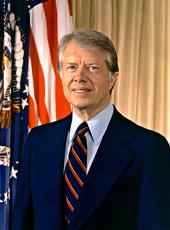We have a very distinguished group here this morning, and I want to thank all of you for coming from different parts of the Nation, from different agencies in the Federal Government, representatives of the private lending sector, and representatives of volunteer groups, counties, cities, States.
When we evolved, with careful consultation among all of us, a new cohesive and, I think, adequate national urban policy, the main point we made was that it would be a new partnership, that the close working relationship and the consultation that evolved the policy itself would be continued in the future in its implementation.
One of the key elements of this partnership, which was, perhaps, not adequately emphasized at the time of the urban policy description to the public, is among the independent financial regulatory agencies in the Federal Government. And this morning, just for a few minutes, I'd like to outline some of the important progress that we have made already, and I hope this will be a basis for even greater future progress.
The Federal Home Loan Bank Board, under Bob McKinney's chairmanship, has evolved a $10 billion Community Investment Fund. This is derived from funds that are within the Federal Home Loan Bank system itself. These are not appropriations from Congress, but the effectiveness of them is just as great, perhaps even greater. Because they will be administered on a regional basis, there's a very tight-knit and effective administrative structure already in place in the private sector of our economy, and the knowledge of local needs is extensive and profound.
I'm very proud of this. These funds will be a supplement to normal moneys available for lending now. They will be concentrated on reinvestment in areas in our urban communities which are badly in need of stimulation, revitalization, of community beautification, financial consultation, the construction of low- and moderate-income housing. Just exactly what's needed in the extensive urban policy to reconstitute the vitality of our deteriorating neighborhoods in this country is what this fund will be used for. I'm very grateful for it, and I believe it will be a major step in the right direction.
I might say in addition that the Comptroller of the Currency and the Federal Home Loan Bank Board and others have combined already to eliminate the adverse consequences of redlining practices. This is a dampening policy on many areas of our Nation that need to be improved. And I think the coordinated study of the problem of redlining has resulted in a great step forward.
Lending institutions who don't want to see their loans lost, who want to minimize defaults, I think, have been adequately heard, and their voices have been part of a very major step toward minimizing redlining.
I'd also like to comment, in closing, on what other regulatory agencies are doing in the financial realm of our Nation. The Comptroller of the Currency has moved to implement a program, similar to the one I've just described, for the thrift institutions in the commercial banking community. The Federal Reserve Board Chairman, Bill Miller, has called publicly for increasing the number of minority citizens, women, representatives of consumer groups, labor, on the boards of the regional Federal banks. And in the Federal Reserve System, this will be a very constructive move. I think that it won't reduce the substantiality and the conservatism and the caution with which our banking system is run. But I think much more enlightened, much more progressive, I think much more sound loan policies can evolve if there's a clearer understanding among those who shape policy of the needs for people who in the past have been excluded.
As you know, Bill Miller has also called for the construction of any new buildings to be located in the areas that are served and which sometimes are tending toward deterioration because they are ignored in the rapid move toward suburbs and more rapidly growing areas. Quite often, the stability of neighborhoods that are in danger of deterioration has been threatened because the very institutions designed to help them move their centers of concentrated attention and presence away. And I think that this is also a step in the right direction.
The Chairman of the Federal Deposit Insurance Commission [Corporation], FDIC, has also evolved a new policy to check compliance with fair housing standards and to emphasize consumer protection. And all these efforts are in consonance, one with another.
Credit unions, in some instances, are badly needed in the neighborhoods that are foremost among those that create concern. An administrator of the National Credit Union Administration is now attempting to analyze on a nationwide basis those communities that can profit from credit unions and institute chapters there which might be both a stabilizing and a constructive step forward.
So, this morning we are very pleased at the Federal Home Loan Bank Board's making available to the public a supplementary opportunity for $10 billion in new loans, and I'm also very thankful that the other regulatory agencies concerned with the financial structure of our country are cooperating as enthusiastically as they can.
We've only had a few weeks, as you know, since the urban policy was revealed. And this progress that we have outlined this morning—I hope it will be just first steps in a concerted, sustained, sometimes even nonpublicized effort to make our Nation a greater one than it already is and to make sure that our urban policy is successful because of the new partnership to which I, as President of our country, am totally committed.
Thank you very much.
Note: The President spoke at 9:30 a.m. in Room 450 of the Old Executive Office Building.
Jimmy Carter, Community Investment Fund Program Remarks at a White House Meeting on the Program. Online by Gerhard Peters and John T. Woolley, The American Presidency Project https://www.presidency.ucsb.edu/node/248472


